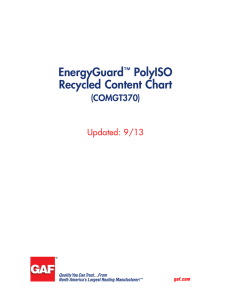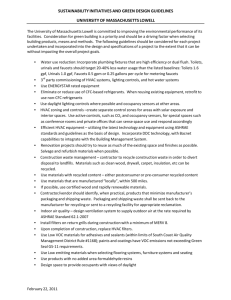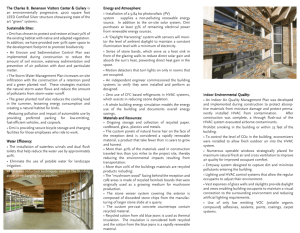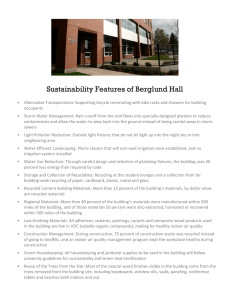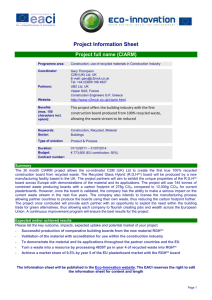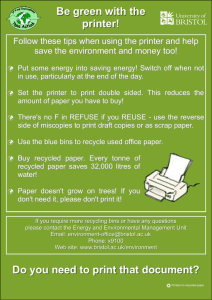Document 12043345
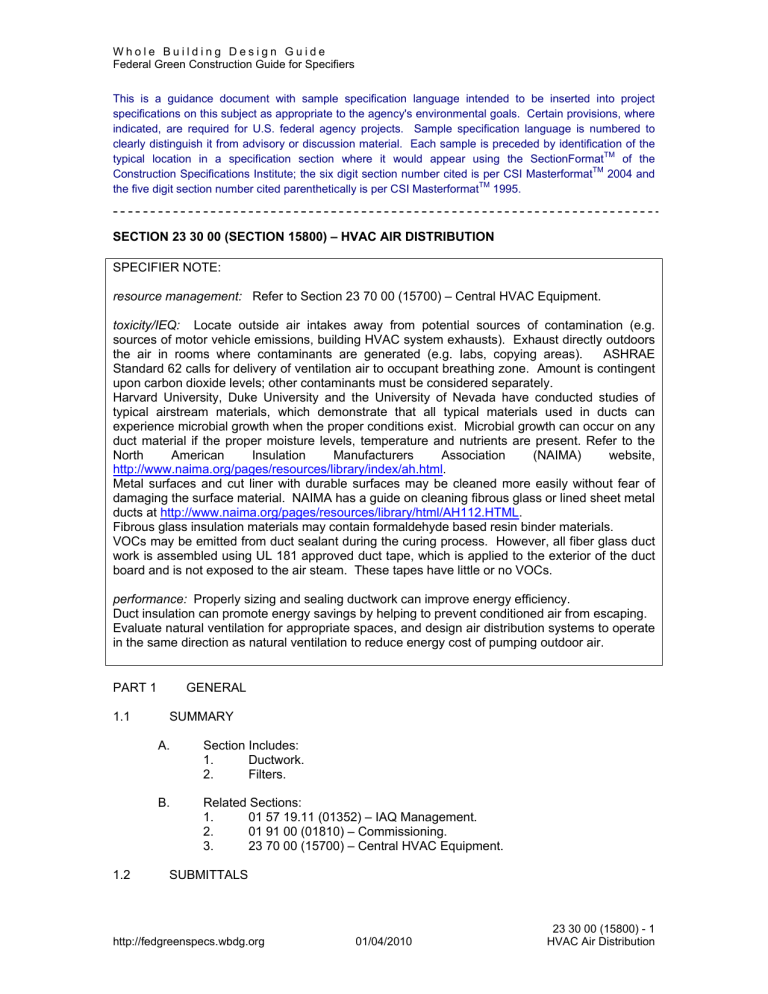
W h o l e B u i l d i n g D e s i g n G u i d e
Federal Green Construction Guide for Specifiers
This is a guidance document with sample specification language intended to be inserted into project specifications on this subject as appropriate to the agency's environmental goals. Certain provisions, where indicated, are required for U.S. federal agency projects. Sample specification language is numbered to clearly distinguish it from advisory or discussion material. Each sample is preceded by identification of the typical location in a specification section where it would appear using the SectionFormat
TM
of the
Construction Specifications Institute; the six digit section number cited is per CSI Masterformat
TM
2004 and the five digit section number cited parenthetically is per CSI Masterformat
TM
1995.
SECTION 23 30 00 (SECTION 15800) – HVAC AIR DISTRIBUTION
SPECIFIER NOTE: resource management: Refer to Section 23 70 00 (15700) – Central HVAC Equipment. toxicity/IEQ: Locate outside air intakes away from potential sources of contamination (e.g. sources of motor vehicle emissions, building HVAC system exhausts). Exhaust directly outdoors the air in rooms where contaminants are generated (e.g. Iabs, copying areas). ASHRAE
Standard 62 calls for delivery of ventilation air to occupant breathing zone. Amount is contingent upon carbon dioxide levels; other contaminants must be considered separately.
Harvard University, Duke University and the University of Nevada have conducted studies of typical airstream materials, which demonstrate that all typical materials used in ducts can experience microbial growth when the proper conditions exist. Microbial growth can occur on any duct material if the proper moisture levels, temperature and nutrients are present. Refer to the
North American Insulation Manufacturers Association (NAIMA) website, http://www.naima.org/pages/resources/library/index/ah.html
.
Metal surfaces and cut liner with durable surfaces may be cleaned more easily without fear of damaging the surface material. NAIMA has a guide on cleaning fibrous glass or lined sheet metal ducts at http://www.naima.org/pages/resources/library/html/AH112.HTML
.
Fibrous glass insulation materials may contain formaldehyde based resin binder materials.
VOCs may be emitted from duct sealant during the curing process. However, all fiber glass duct work is assembled using UL 181 approved duct tape, which is applied to the exterior of the duct board and is not exposed to the air steam. These tapes have little or no VOCs. performance: Properly sizing and sealing ductwork can improve energy efficiency.
Duct insulation can promote energy savings by helping to prevent conditioned air from escaping.
Evaluate natural ventilation for appropriate spaces, and design air distribution systems to operate in the same direction as natural ventilation to reduce energy cost of pumping outdoor air.
PART 1 GENERAL
1.1 SUMMARY
A. Section Includes:
1. Ductwork.
2. Filters.
1.
2.
3.
01 57 19.11 (01352) – IAQ Management.
01 91 00 (01810) – Commissioning.
23 70 00 (15700) – Central HVAC Equipment.
1.2 SUBMITTALS http://fedgreenspecs.wbdg.org 01/04/2010
23 30 00 (15800) - 1
HVAC Air Distribution
W h o l e B u i l d i n g D e s i g n G u i d e
Federal Green Construction Guide for Specifiers
A. Product data. Unless otherwise indicated, submit the following for each type of product provided under work of this Section:
SPECIFIER NOTE:
Green building rating systems often include credit for materials of recycled content. USGBC-
LEED™ v3, for example, includes credit for materials with recycled content, calculated on the basis of pre-consumer and post-consumer percentage content, and it includes credit for use of salvaged/recovered materials.
Green Globes US also provides points for reused building materials and components and for building materials with recycled content.
1. Recycled Content: a. Indicate recycled content; indicate percentage of pre-consumer b. c. and post-consumer recycled content per unit of product.
Indicate relative dollar value of recycled content product to total dollar value of product included in project.
If recycled content product is part of an assembly, indicate the d. percentage of recycled content product in the assembly by weight.
If recycled content product is part of an assembly, indicate relative dollar value of recycled content product to total dollar value of assembly.
SPECIFIER NOTE:
Specifying local materials may help minimize transportation impacts; however it may not have a significant impact on reducing the overall embodied energy of a building material because of efficiencies of scale in some modes of transportation.
Green building rating systems frequently include credit for local materials. Transportation impacts include: fossil fuel consumption, air pollution, and labor.
USGBC-LEED™ v3 includes credits for materials extracted/harvested and manufactured within a
500 mile radius from the project site. Green Globes US also provides points for materials that are locally manufactured.
2. Local/Regional Materials: a. Sourcing location(s): Indicate location of extraction, harvesting, and recovery; indicate distance between extraction, harvesting, b. and recovery and the project site.
Manufacturing location(s): Indicate location of manufacturing facility; indicate distance between manufacturing facility and the project site. c. d.
Product Value: Indicate dollar value of product containing local/regional materials; include materials cost only.
Product Component(s) Value: Where product components are sourced or manufactured in separate locations, provide location information for each component. Indicate the percentage by weight of each component per unit of product.
SPECIFIER NOTE:
Green building rating systems may include credit for low emitting materials. USGBC-LEED™ v3, for example, includes credits for low-emitting materials, including: adhesives and sealants.
Under LEED™ v3, adhesives and sealants are to comply with California’s South Coast Air Quality
Management District (SCAQMD) #1168; aerosol adhesives are to comply with Green Seal GS-
36.
As per USGBC published Credit Interpretations, the credits for low-emitting materials are directed towards interior, site-installed (i.e. not prefabricated) products. Verify project requirements for low
VOC products that meet SCAQMDd #1168. http://fedgreenspecs.wbdg.org 01/04/2010
23 30 00 (15800) - 2
HVAC Air Distribution
W h o l e B u i l d i n g D e s i g n G u i d e
Federal Green Construction Guide for Specifiers
A.
B.
Energy Efficiency: Meet or exceed ASHRAE 90.1.
PART 2
Indoor Environmental Quality:
1. Ventilation: Meet or exceed ASHRAE 62 and all published addenda.
2. Filtration: Meet or exceed filter media efficiency as tested in accordance with ASHRAE 52.2
– 1999 (or most recent version).
3.
4.
Thermal Comfort: Meet or exceed ASHRAE 55.
Maintain positive pressure within the building.
PRODUCTS
SPECIFIER NOTE:
EO 13423 includes requirements for Federal Agencies to use “sustainable environmental practices, including acquisition of biobased, environmentally preferable, energy-efficient, waterefficient, and recycled-content products”
Specifically, under the Sustainable Building requirements per Guiding Principle #5 Reduce
Environmental Impact of Materials, EO13423 directs Federal agencies to “use products meeting or exceeding EPA's recycled content recommendations” for EPA-designated products and for other products to “use materials with recycled content such that the sum of post-consumer recycled content plus one-half of the pre-consumer content constitutes at least 10% (based on cost) of the total value of the materials in the project.”
Executive Order 13514; Federal Leadership in Environmental, Energy, and Economic
Performance ; was signed on October 5, 2009. http://www.ofee.gov/execorders.asp
It expands upon the environmental performance requirements of EO 13423. http://www1.eere.energy.gov/femp/regulations/printable_versions/eo13423.html
EO 13514 sets numerous federal requirements in several areas, including sustainable buildings and communities. Federal agencies must implement high performance sustainable federal building design, construction, operation and management, maintenance, and deconstruction, including:
Ensuring all new Federal buildings, entering the design phase in 2020 or later, are designed to achieve zero net energy by 2030.
Ensuring all new construction, major renovations, or repair or alteration of Federal buildings comply with the Guiding Principles of Federal Leadership in High Performance and
Sustainable Buildings http://www1.eere.energy.gov/femp/pdfs/mouhighperfsustainfedfacs.pdf
Ensuring at least 15% of existing agency buildings and leases (above 5,000 gross square feet) meet the Guiding Principles by fiscal year 2015 and that the agency makes annual progress towards 100% compliance across its building inventory.
Additionally, for USDA-designated biobased products, Federal agencies must use products meeting or exceeding USDA's biobased content recommendations; and for other products, biobased products made from rapidly renewable resources and certified sustainable wood products.
2.1 MATERIALS
A. Ductwork:
SPECIFIER NOTE:
Green building rating systems often include credit for materials of recycled content and may distinguish allowable credit for post-consumer and post-industrial (or pre-consumer) recycled content. USGBC-LEED™ v3, for example, factors 100 percent of post-consumer recycled content but only 50 percent of pre-consumer (post-industrial) recycled content into calculations for its recycled content materials credit. LEED v3 grants one credit to a project for using materials with http://fedgreenspecs.wbdg.org 01/04/2010
23 30 00 (15800) - 3
HVAC Air Distribution
W h o l e B u i l d i n g D e s i g n G u i d e
Federal Green Construction Guide for Specifiers recycled content such that the sum of post-consumer recycled content plus one-half of the postindustrial content constitutes at least 10 percent of the total value of the materials in the project;
10% (post-consumer + 1/2 post-industrial). It grants an additional point for 20% (post-consumer
+ 1/2 post-industrial).
Green Globes US also provides points for reused building materials and components and for building materials with recycled content.
Recycled content is typically determined by calculating the weight of the recycled material divided by the total weight of the product and expressed as a percentage by weight. (The recycled content “value” of a product as assessed under LEED is determined by multiplying the recycled content percentage and the cost of the product.)
Verify with manufacturer for product availability and recycled content.
1. Recycled Content: Minimum [5] [10] [xxxx] percent post-consumer recycled content, or minimum [20] [40] [xxxx] percent pre-consumer recycled content at contractor’s option.
2. Toxicity/IEQ: a. Mold/mildew growth management: [Unfaced fiberglass and mineral fiber insulation will not be permitted in contact with b. airstream.] [Duct liner will not be permitted.] [Provide duct liner with durable surface in contact with airstream.]
Acoustical performance: Provide [ one-third] [full] octave bands of airflow generated noise for each rate and direction of airflow of design performance in accordance with [ASTM E477] [ARI 260
(ducted equipment) [ ARI 300 (terminal equipment)] . Indicate pressure drop across the silencing element for each airflow rate.
B. Filters:
SPECIFIER NOTE:
USGBC-LEED™ v3 includes credit for an IAQ Management plan consistent with SMACNA IAQ
Guidelines and including the use of MERV 8 filtration media.
MERV 13 filters are typically at least 6 inches deep with 0.8” wg pressure drop or higher, making them only feasible in applied, belt-driven central station air handling units. Terminal equipment or smaller packaged rooftop equipment cannot achieve this level of filtration or generate the static pressure needed to deliver proper airflow when using this high efficiency filtration. Typically
MERV 6 or 8 is the highest efficiency filter that can be applied for that equipment.
1. Toxicity/IEQ: Provide filtration media with a Minimum Efficiency
Reporting Value (MERV) of [6] [8] [13] as determined by ASHRAE 52.2.
PART 3 - EXECUTION
A. Commissioning: The project will have selected building systems commissioned.
Coordinate with commissioning as specified in Section 01 91 00 (01810) -
Commissioning.
1. Temporary ventilation: as specified in Section 01 57 19.11 (01352) –
Indoor Air Quality (IAQ) Management, and as follows:
SPECIFIER NOTE:
HVAC components can affect the IAQ for the building. Refer to http://www.epa.gov/iaq/schooldesign/hvac.html
EPA IAQ Design Tools for Schools for additional information.
The sheet steel used to make ducts has a thin petroleum or fish oil coating primarily intended to inhibit corrosion during transportation and storage of the steel. This coating may trap dirt particles, some people find the odor objectionable, and there are concerns that the emissions http://fedgreenspecs.wbdg.org 01/04/2010
23 30 00 (15800) - 4
HVAC Air Distribution
W h o l e B u i l d i n g D e s i g n G u i d e
Federal Green Construction Guide for Specifiers from the coating could affect individuals with asthma or allergies. One solution is to remove the coating from the duct using a mild cleaning agent, such as a household dishwashing liquid, in conjunction with a heated high-pressure sprayer.
In addition to significant energy losses, air leakage from HVAC ducts and air handling units can cause significant IAQ problems due to unexpected airflow between indoors and outdoors, and between areas within the school. Air leakage from supply or return duct work contributes to the condensation of humid air in building cavities and/or on the neighboring surfaces. Air leakage can be especially problematic for ducts or AHUs that are located outside the conditioned spaces. a. b. c. d.
Degrease sheet metal air ducts.
Seal air ducts to prevent HVAC system air leakage.
Install duct insulation so that unfaced fiberglass and mineral fiber insulation are not in contact with airstream.
Clean ductwork in accordance with manufacturer’s recommendations [and the NAIMA Guide on Cleaning Fibrous
Glass Insulated Air Duct Systems] .
1.
END OF SECTION
Energy Efficiency: Verify equipment is properly installed, connected, and adjusted. Verify that equipment is operating as specified. http://fedgreenspecs.wbdg.org 01/04/2010
23 30 00 (15800) - 5
HVAC Air Distribution

